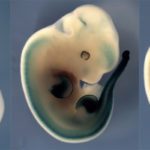Link to Pubmed [PMID] – 20795322
Adv. Exp. Med. Biol. 2010;689:63-78
Despite apparently shared structural organisation and functional roles, vertebrate Hox genes are controlled by regulatory mechanisms rather distinct from those of the prototypic Drosophila Antennapedia (ANT-C) and Bithorax (BX-C) Complexes. If individual regulatory modules have been shown to recapitulate specific Hox expression patterns, other experimental studies underscore that vertebrate Hox clusters are controlled in many of their functions in a global manner, through distinct mechanisms. We will discuss the different models that have been proposed to account for these global regulatory modes. In this context, the studies of the regulation of the HoxD complex during limb development highlighted the role of global regulatory elements and the different mechanisms associated to transform a structural organisation into distinct temporal and spatial expression domains. We will further discuss how these mechanisms may have benefited from the structure of the vertebrate homeotic clusters and reciprocally contribute to shape their evolution towards an increased level of organisation and compaction.

